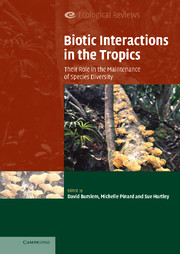Book contents
- Frontmatter
- Contents
- List of contributors
- Preface
- PART I Plant–plant interactions
- PART II Plant–microbe interactions
- PART III Plant–animal interactions
- 10 Implications of plant spatial distribution for pollination and seed production
- 11 Seed dispersal of woody plants in tropical forests: concepts, examples and future directions
- 12 The role of trophic interactions in community initiation, maintenance and degradation
- 13 Impacts of herbivores on tropical plant diversity
- 14 Have the impacts of insect herbivores on the growth of tropical tree seedlings been underestimated?
- 15 Multi-trophic interactions and biodiversity: beetles, ants, caterpillars and plants
- 16 The trophic structure of tropical ant–plant–herbivore interactions: community consequences and coevolutionary dynamics
- 17 Multitrophic interactions in a neotropical savanna: ant–hemipteran systems, associated insect herbivores and a host plant
- PART IV Biotic interactions in human-dominated landscapes
- Index
- References
17 - Multitrophic interactions in a neotropical savanna: ant–hemipteran systems, associated insect herbivores and a host plant
Published online by Cambridge University Press: 25 August 2009
- Frontmatter
- Contents
- List of contributors
- Preface
- PART I Plant–plant interactions
- PART II Plant–microbe interactions
- PART III Plant–animal interactions
- 10 Implications of plant spatial distribution for pollination and seed production
- 11 Seed dispersal of woody plants in tropical forests: concepts, examples and future directions
- 12 The role of trophic interactions in community initiation, maintenance and degradation
- 13 Impacts of herbivores on tropical plant diversity
- 14 Have the impacts of insect herbivores on the growth of tropical tree seedlings been underestimated?
- 15 Multi-trophic interactions and biodiversity: beetles, ants, caterpillars and plants
- 16 The trophic structure of tropical ant–plant–herbivore interactions: community consequences and coevolutionary dynamics
- 17 Multitrophic interactions in a neotropical savanna: ant–hemipteran systems, associated insect herbivores and a host plant
- PART IV Biotic interactions in human-dominated landscapes
- Index
- References
Summary
Introduction
In many habitats ants form a major part of the arthropod fauna found on vegetation, and recent studies have shown that the abundance and diversity of ant–plant associations is particularly remarkable in the tropical region. For instance, one-third of the plant species in a Panamanian forest (Schupp & Feener 1991) and over 20% of the woody species in a Brazilian savanna (Oliveira & Oliveira-Filho 1991) were found to produce ant rewards. Furthermore, 312 ant–plant interactions were recorded in one Mexican coastal site (Rico-Gray 1993), and the ant–plant community in an Amazonian rainforest comprised 377 plants per ha (Fonseca & Ganade 1996). In the tropics many ant species use plant surfaces as a foraging substrate to search for both live and dead animal prey, as well as for different types of plant-derived food products (Carroll & Janzen 1973). Ant activity on foliage can be promoted by the occurrence of predictable and immediately renewable food sources, in cluding extrafloral nectar, honeydew from phloem-feeding hemipterans, and secretions from lepidopteran larvae (see Way 1963; Bentley 1977; Buckley 1987; Koptur 1992; Pierce et al. 2002). In fact, plant- and insect-derived liquid foods appear to provide a large amount of the energy supply of foliage-dwelling ants (Tobin 1994; Davidson et al. 2003). Although food resources located on foliage are probably more often found and exploited by arboreal species, ground-nesting ants frequently extend their foraging areas onto the plant substrate as well (Rico-Gray 1993; Blüthgen et al. 2000; Davidson et al. 2003).
- Type
- Chapter
- Information
- Biotic Interactions in the TropicsTheir Role in the Maintenance of Species Diversity, pp. 414 - 438Publisher: Cambridge University PressPrint publication year: 2005
References
- 30
- Cited by



